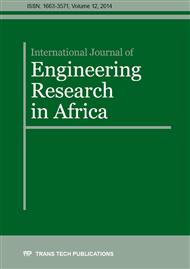[1]
D.N.P Murthy, M. Rausand, T.steras, Product Reliability: Specification and Performance, Springer Series in Reliability Engineering, Springer-Verlag, London, U.K, 2008.
DOI: 10.1007/978-1-84800-271-5
Google Scholar
[2]
M. Modarras, M. Kaminskiy, V. Krivtsov, Reliability Engineering and Risk Analysis: A Practical Guide (Quality & Reliability), Marcel Dekker Inc. N.Y., U.S.A, 1999.
Google Scholar
[3]
J.W. Evans, J.Y. Evans, Product Integrity and Reliability in Design, Springer-Verlag, London, U.K, 2001.
Google Scholar
[4]
A. Mettas, M. Savva, System Reliability Analysis: The Advantages of Using Analytical Methods to Analyse Non-Repairable Systems, Proceedings Annual Reliability and Maintainability Symposium (2001) 80-85.
DOI: 10.1109/rams.2001.902446
Google Scholar
[5]
H. Hecht, Systems Reliability and Failure Prevention, Artech House, Boston, USA, 2004.
Google Scholar
[6]
S. Dhillon, Reliability, Quality, and Safety for Engineering, CRC Press, U.S.A, 2005.
Google Scholar
[7]
B.J. Bernstein, M. Gurfinkel, X. Li, J. Walter, Y. Shapira, M. Talmor, Electronic Circuit Reliability Modelling, Microelectronics Reliability 46 (2006) 1957-1979.
DOI: 10.1016/j.microrel.2005.12.004
Google Scholar
[8]
R.M. Cranwell, Ground Vehicle Reliability Design-for-Reliability, DoD Maintenance Symposium, Orlando, Florida, November (2007) 13-16.
Google Scholar
[9]
I.J. James, J. Marshall, L. Walls, Improving Design for Reliability with In-Service Data Analysis, Proceedings, Annual Reliability and Maintainability Symposium, Seattle WA, USA (2002) 417 – 422.
DOI: 10.1109/rams.2002.981677
Google Scholar
[10]
S.B. Twum E. Aspinwall, Complex System Reliability Optimization: A Multi-criteria Approach, International Journal of Engineering Research in Africa 9 (2013) 13 – 21.
DOI: 10.4028/www.scientific.net/jera.9.13
Google Scholar
[11]
S.B. Twum, E. Aspinwall, J. Fliege, A Multi-criteria Optimization Model for Reliability Design of Series-Parallel Systems: Part 1, International Journal of Quality and Reliability Management 29 (9) (2012) 1038 – 1055.
DOI: 10.1108/02656711211272944
Google Scholar
[12]
W. Kuo, V.R. Prasad, F.A. Tillman, C. Hwang, Optimal Reliability Design: Fundamentals and Applications, Cambridge University Press, U.K., 2001.
Google Scholar
[13]
W. Kuo, R. Prasad, An Annotated Overview of System-Reliability Optimization, IEEE Transactions on Reliability 49 (2) (2000) 176-18.
DOI: 10.1109/24.877336
Google Scholar
[14]
A. Mohamed, L.M. Leemis, A. Ravindran, Optimization Techniques for System Reliability: A Review, Reliability Engineering and System Safety 35 (1992) 137-146
DOI: 10.1016/0951-8320(92)90033-h
Google Scholar
[15]
C. Wang, (2008) Reliability Optimization of a Non-repairable Compound Series-Parallel System, Journal of the Chinese Institute of Industrial Engineering 25 (2) (2008) 116-126.
DOI: 10.1080/10170660809509077
Google Scholar
[16]
A.Mettas, ReliaSoft Corporation Tucson, Reliability Allocation and Optimization of Complex Systems, Proceedings, Annual Reliability and Maintainability Symposium, Los Angeles, California January 24-27 (2000)1-6.
DOI: 10.1109/rams.2000.816310
Google Scholar
[17]
Reliability HotWire, Reliability Allocation and Optimisation, The eMagazine for the Reliability Professional Issue 6, August 2001. ReliaSoft Corporation USA URL: http://www.weibull.com/hotwire/issue6/hottopics6.htm (Accessed: 07/04/2008)
Google Scholar
[18]
R.T. Marler, A Study of Multi-objective Optimization Methods for Engineering Applications,Unpublished PhD Thesis, Graduate College of The University of Iowa, Iowa City, Iowa, 2005.
Google Scholar
[19]
A. Petrovski, J. McCall, Multi-objective optimisation of Cancer Chemotherapy using Evolutionary Algorithms, Proceedings of First International Conference on Evolutionary Multi-criteria Optimisation, Zurich, Switzerland (2001) 531 – 545.
DOI: 10.1007/3-540-44719-9_37
Google Scholar
[20]
H.A. Taboada, D.W. Coit, Data Clustering of Solutions for Multiple Objective System Reliability Optimization problems, Quality Technology and Qualitative Management Journal 4 (2) (2007) 35-54.
DOI: 10.1080/16843703.2007.11673145
Google Scholar
[21]
D.W. Coit, A. Konak, (2006) Multiple Weighted Objectives Heuristic for the Redundancy Allocation Problem, IEEE Transactions on Reliability 55 (3) (2006) 551-558.
DOI: 10.1109/tr.2006.879654
Google Scholar
[22]
R.T. Marler, J.S. Arora, Survey of Multi-objective optimization methods For Engineering, Structural And Multidisciplinary Optimization 26 (2004) 369-395.
DOI: 10.1007/s00158-003-0368-6
Google Scholar
[23]
I.Y. Kim, de O.L. Weck, Adaptive Weighted-Sum Method for Bi-objective Optimization: Pareto Front Generation, Structural and Multidisciplinary Optimization 29 (2005) 149-158.
DOI: 10.1007/s00158-004-0465-1
Google Scholar
[24]
R. Billinton, R.N. Allan, Reliability Evaluation of Engineering Systems 2nd Ed, Plenum Press USA, 1992.
Google Scholar


